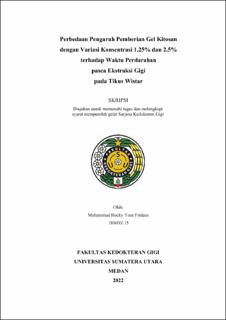Perbedaan Pengaruh Pemberian Gel Kitosan dengan Variasi Konsentrasi 1.25% dan 2.5% terhadap Waktu Perdarahan Pasca Ekstraksi Gigi pada Tikus Wistar
Differences in the Effect of Chitosan Gel Application with Concentrations Variations of 1.25% and 2.5% on Bleeding Time Following Dental Extraction in Wistar Rats

Date
2022Author
Firdaus, Muhammad Hocky Yoes
Advisor(s)
Rusdy, Hendry
Agusnar, Harry
Metadata
Show full item recordAbstract
Tooth extraction is a process of removing the tooth from the alveolus, where
the tooth can no longer be treated. Not all patients who come for tooth extraction have a good physiological and hemostatic conditions, so it is necessary to consider using hemostatic agents in an effort to control bleeding so that they can produce stable blood clots and accelerate the wound healing process. Chitosan is an excellent hemostatic agent because it can induce platelets to adhere, activate, and accumulate at the site of vascular injury. This study aims to determine the difference in the effect of chitosan gel with a concentration variations of 1.25% and 2.5% on bleeding time after tooth extraction of wistar rats. This type of study is experimental in vivo with post-test only control group design. The sample of this study used 24 male wistar rats which were divided into 4 groups, namely negative control (K1), positive control (K2), chitosan gel with concentration variations of 1.25% (K3) and 2.5% (K4) as a treatment groups. Based on the results of the Post-hoc LSD test, it showed that the average bleeding time of the treatment groups were significantly shorter compared to the negative control group with a p value=0.000 (p <0.05). The average bleeding time for the chitosan gel group was significantly shorter with the concentration of 2.5% compared to the 1.25% with a p value=0.001 (p<0.05).
Collections
- Undergraduate Theses [1911]
